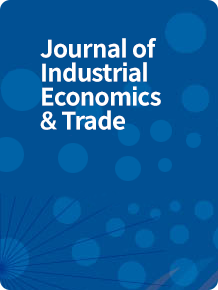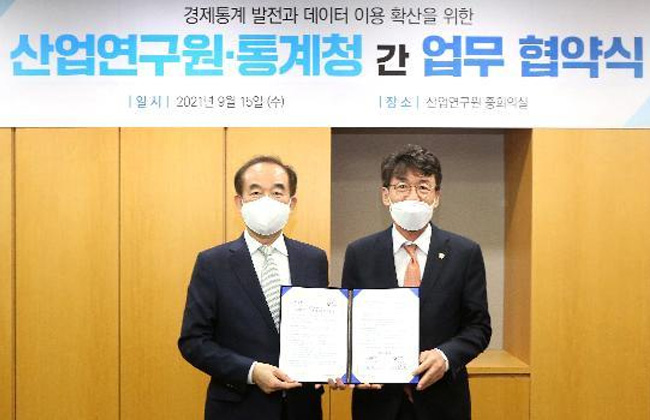Journal of Industrial Economics & Trade

Showing 78 results
-
Analysis of Job and Skill Demand in the Information and Communication Industry Using Job Posting Data
Kim Gyuhwan 2025.12.31
In response to the ICT industry’s growing labor shortage, this study analyzed job postings by company type and experience to identify workforce needs using Social Network Analysis (SNA). Experienced candidates were in higher demand than entry-level ones. Java and Linux remained essential, while Python and AWS demand grew among experienced professionals, serving as key connectors in the job–skill network. Entry-level System Engineer roles were linked to Linux, whereas experienced Back-end Developer roles were tied to Java and MySQL. The study recommends: strengthening education–employment links and public R&D support for SMEs; and (2) developing flexible, demand-driven training programs to enhance skills -
Energy R&D Investment and Carbon Intensity in OECD Countries
Oh Hyungna; Kim Jee Young 2025.04.30
This study investigates the impact of public research and development (R&D) investment in energy technology on carbon intensity across 30 OECD countries from 1995 to 2020. The results of the empirical exercise, employing the IEA Energy Technology RD&D Budgets database, show that per capita CO2 significantly decreases in the share of energy R&D investment relative to GDP. However, it takes two- to three years to see the effects of these investments. Our findings emphasize the role of carbon pricing mechanisms, such as emissions trading systems and carbon taxation. Robustness tests on the dynamic panel model confirm the impact of energy R&D on emissions reduction.
-
An Empirical Analysis of Heterogeneous Growth Types of Korean Startups and Their Determinants
Lee Kyunghee; Han Changyong 2025.12.31
This study classifies the growth trajectories of Korean startups and empirically analyzes the factors that influence their growth types. Using panel data from “Innoforest” and “Korea Rating and Data”, we estimate the growth speed and acceleration of sales and accumulated investment during years 2 to 6 after founding through a growth curve model. Based on these estimated dynamic indicators, we apply cluster analysis to categorize startup growth trajectories into four distinct types.
The results show that the majority of startups fall into either the “General Growth Type” (77.4%), characterized by modest early growth that gradually accelerates, or the “Post-Growth Plateau Type” (13.8%), which experiences initial expansion followed by decelerating growth. A smaller group of startups exhibits rapid early growth, which is further classified into an “Accelerating High-Growth Type” (5.5%), where growth continues to accelerate over time and a “Decelerating High-Growth Type” (3.3%), where early rapid growth slows in later years.
A multi-nomial logit analysis of the determinants of these growth types reveals that industry sector, geographic location, early-stage investment, early R&D activities, and initial financial soundness are all significantly associated with the likelihood of belonging to each growth category.
These findings highlight the heterogeneous nature of startup growth trajectories and suggest that early conditions and strategic decisions play a critical role in shaping the sustainability and direction of startup growth. -
The Impact of US Political Uncertainty in Korean Firms’ Short-term Stock Price: Evidence from the 2024 Trump Assassination Attempt
Kwon Yonghyun; Park Yongjin; Kang Bo Kyung 2025.12.31
Our study analyze the impact of changes in the U.S. political uncertainty on Korean listed firms’ short-term stock price, focusing on the assassination attempt on Donald Trump, the Republican presidential candidate, that occurred on July 13, 2024. Using event study method, we examines 664 cases of companies listed on the KOSPI market through univariate analysis and multiple regression analysis to identify the determinants of Cumulative Abnormal Returns (CARs) and Buy-and-Hold Abnormal Returns (BHARs). Our empirical results are as follows: an industry-level analysis world input-output tables revealed that firms belonging to industries with higher linkages to the U.S. and China were more negatively affected, We measure foreign dependency through the export ratio (%) of sales and company history analysis, finding that firms with higher export ratios are more severely affected. Our study suggest that dramatic political shifts in the U.S., such as an assassination attempt, affects on Korean firms’ performance, with implications for understanding the influences at both the industry and firm levels, as well as policy differences.
-
Optimal Choice Analysis of Direct LNG Importers in Response to Spot Price Fluctuation: Overseas Resale of Long-term Volumes and Increasing Spot Ratio
Song Jae-do; Hong Hyunwoo 2025.08.29
Amid soaring LNG spot prices, concerns have emerged regarding potential strategic behaviors by direct LNG importers, which may increase their profits at the expense of Korea Gas Corporation and users of the average rate system. These concerns stem from observed patterns of reduced direct imports during periods of high spot prices and increased direct imports when spot prices fall. However, direct LNG importers argue that such behavior is infeasible under the current system, as selective purchases based on spot price fluctuations are not allowed. To address this controversy, this study examines the mechanisms underlying fluctuations in spot prices and direct import volumes. The findings reveal that direct LNG importers have an incentive to enhance profits by reselling long-term contracted volumes to overseas markets and intentionally increasing the proportion of spot market purchases during periods of high spot prices. This behavior explains the observed trends in spot price and direct import volumes. Furthermore, the study theoretically investigates how these actions disadvantage Korea Gas Corporation and users of the average rate system. These findings clarify the optimal choice of direct LNG importers and offer policy implications for regulating future direct LNG import practices
-
Analyzing the Relationship Between Hiring Safety and Health Managers and Industrial Accident Prevention
Gil Eunsun; Kim Donggeun 2025.08.29
The long-term decline in industrial accidents in South Korea has recently reversed due to expanded recognition criteria and increased approval rates. In response, policy discussions continue over increasing the employment of dedicated safety and health managers to enhance workplace safety. This study empirically examines their impact using data from the Industrial Safety and Health Survey.
The results show that in manufacturing and services, appointing at least one safety manager reduces serious accidents, with additional hires offering diminishing returns. Health managers help prevent minor accidents but show no added effect with further appointments. In construction, higher occupational safety and health (OSH) expenditures are more effective in reducing accidents than increasing manager numbers.
These results suggest that simply increasing the number of dedicated managers is insufficient. Instead, effective policies should target industry- specific risks and adopt a fault-based, differentiated regulatory framework that adjusts oversight based on accident history and demonstrated safety efforts.
-
Consumer Preference Analysis for Confidentiality, Security and Expertise in the Testing and Certification Industry
Kim Sungyoon; Choi Donghwan ; Shim Dongnyok 2025.08.29
The TIC(Testing, Inspection, Certification) industry has long developed into an oligopolistic service market where a small number of companies provide services under state management and supervision. In this process, the industry is facing an industry-wide crisis due to the lack of response to ICT convergence and market opening. In this context, this study examines key factors influencing the competitiveness of the testing and certification industry, focusing on confidentiality and expertise. Using conjoint analysis, we assess the part-worth values of key attributes, including original document tamper prevention, digital test reports, the number of confidentiality violations, competency of testing personnel, investment rate in testing and certification infrastructure, report quality, and service fees. The results indicate that confidentiality is more critical than expertise, with confidentiality violations and tamper prevention having the greatest impact on client preferences. Market share simulations demonstrate that improvements in confidentiality and expertise significantly contribute to market expansion, while fee reductions serve as an effective strategy for strengthening competitiveness. This study provides practical insights for testing and certification institutions, highlighting the need to enhance confidentiality, expertise, and pricing strategies to improve service reliability and professionalism
-
A Study on the Incentives for Innovation in E-commerce Sales Companies: Focusing on Market Environment and Platform Strategies
Kang Minji 2025.08.29
This study analyzes the determinants of innovation among sellers in the digital platform-based e-commerce market and examines the impact of the market structure formed by platforms on companies’ strategic choices. Specifically, it compares the effects of market environment factors perceived by companies (e.g., degree of competittion and technological uncertainty) and market strategies (e.g., platform selection, multi-homing, and export status) on various innovation indicators (product innovation, service innovation, business process innovation, innovation activities, innovation collaboration, and digital transformation) across different industries.
The analysis employed a comprehensive set of data, integrating the Fair Trade Commission’s registry of telecommunications sales companies with Market DB Pro’s list of platform-using sales companies, along with the Korea Institute of Science and Technology Policy’s corporate innovation survey data. To analyze the differences in the average innovation indicators across market environments, an independent samples t-test was employed. In addition, to analyze the impact of distribution strategies on innovation incentives, a Probit model was used for the binary innovation indicators.
This study aims to clarify the structural conditions and industry-specific heterogeneity surrounding innovation incentives for sellers in the platform industry and provide an empirical foundation for balanced policy design. -
Economic Analysis for Demand Response using Stochastic Approach in South Korea
Lee Chul-Yong 2025.04.30
UK spec may vary. Based on In the process of implementing carbon neutrality around the world,eco-friendly energy such as renewable energy is expanding. Because renewable energy, however, is highly variable and has a distributed form of energy, new challenges are created in balancing electricity demand and supply at the local level. Korea’s demand response projects have been mainly implemented in industrial and commercial sectors with high electricity consumption, but since 2018, small-scale demand response projects have been implemented for residential use as well. This study targets demand response projects in the industrial, commercial, and residential power sectors and estimates cost-benefit ratio (BC ratio), net present value (NPV), and internal rate of return (IRR). and break-even point (payback period). However, since the demand response project is a project in which the government intervenes and receives national subsidies, it should be analyzed separately from the government perspective and the user perspective. Additionally, in order to reflect the uncertainty of cost and benefit variable, this study intends to perform a stochastic economic analysis using Monte Carlo simulation methods. The result shows that in the case of the residential demand response project, the economic feasibility was very low from the government perspective due to the large amount of government subsidies, but from the user perspective, the economic feasibility was very high. In the case of commercial and industrial demand response projects, it was found that there was a need to expand their distribution as it is a desirable policy that can achieve a win-win for all stakeholders by securing economic feasibility from both the government and user perspectives. -
Measuring the Global Value Chain in the Chungcheong Region using Regional and International Input-Output Table
Jeon Kiyoung 2025.04.30
This study examines the participation of the Chungcheong region in the global value chain (GVC), which has a large intermediate trade scale and an economic scale similar to that of Greece and Portugal. To measure the GVC participation of the Chungcheong region, the regional input-output tables of the Bank of Korea and the multi-regional input-output table (MRIO) of the Asian Development Bank (ADB) were integrated and connected in 2010, 2013, and 2015. First, the Chungcheong region was integrated from Daejeon, Sejong, Chungnam, and Chungbuk regions into a regional input-output table composed of two regions: Chungcheong and other regions outside of Chungcheong. The ADB's MRIO was integrated into an international input-output table consisting of Korea and other countries, and the Korean portion of the international input-output table was integrated using the regional input-output table composed of two regions previously prepared. The GVC participation of the Chungcheong region measured using the MRIO was found to be much higher than that of regions outside of Chungcheong and even higher than that of Greece and Portugal with similar economic scales.
When examining the forward and backward participation of the GVC, the Chungcheong region showed a steady rate of around 45% for each during the target period. Furthermore, when divided into simple and complex participation, the forward simple participation rate of the Chungcheong region was higher than its complex participation rate, which was similar to that of regions outside of Chungcheong. However, the backward complex participation rate of the Chungcheong region was higher than its simple participation rate, which was different from other regions outside of Chungcheong. When examining by industry, the GVC participation of the manufacturing industry in the Chungcheong region was higher than that of the service industry, especially in the chemical,
electrical and electronic equipment and precision instruments, and transport equipment industries. However, the transport equipment industry showed a different pattern from other industries, with a higher forward complex participation rate than its forward simple participation rate.
Please enter the security text below
to prevent email collection
Please check the information of the person in charge.
연구과제 제안이 접수되었습니다.
신청이 접수되었습니다.


View Summary
코로나19 발생 이후 대부분의 고용 관심사가 항공 및 여행서비스, 음식·숙박 서비스 등 주로 서비스 업종에 집중된 상황에서 본 연구는 최근 그 중요성이 강조되고 있는 제조업의 고용변화를 살펴보았다. 분석에 따르면, 코로나19 이후 제조업 고용은 비교적 큰 충격 없이 빠르게 회복하는 모습을 보이고 있다. 제조업 고용은 서비스업에 비해 큰 충격 없이 유지되고 있고, 코로나19 직후 2020년 상반기에 약간 하락하였지만 하반기부터 회복 추세를 보이고 있으며, OECD 주요국의 제조업과 비교하여도 일본과 함께 고용 충격이 비교적 작게 나타나고 있다. 그러나 전반적으로 양호한 고용 성적에도 불구하고 제조업 내 특성 별로는 차이가 나타나는 것으로 보인다. 종사상 지위 별로 보면, 임시·일용직, 고용원이 있는 자영업자에서 고용 충격이 상대적으로 크게 나타났고, 상용직과 고용원이 없는 자영업자는 큰 충격이 없는 것으로 나타났다. 제조업 규모별로는 300인 이상의 경우 코로나 발생 초기 약간의 충격 이후 고용이 빠르게 반등하면서 코로나 이전보다 고용이 더 증가한 반면, 이보다 작은 규모의 제조업체들의 경우 고용 회복이 더디게 나타나고 있다. 고용의 중장기, 단기 추세선을 비교한 결과 제조업 업종에 따른 차이를 보였다. 코로나 발생 이전 3년간의 추세선을 2020년 1월부터 연장한 선과, 2020년 1월부터의 실제 자료를 이용한 단기 추세선을 비교한 결과, 의약품은 코로나19 발생 이전부터 시작하여 코로나19 발생 이후에도 견조한 증가세를 유지하고 있으며, 전자부품·컴퓨터, 기타운송장비, 가구는 코로나19 이후 오히려 고용 추세가 개선되었다. 그러나 다수 업종은 코로나 발생 이후 고용이 하락하였는데, 특히, 비금속광물, 1차금속, 금속가공 분야나 인쇄·기록매체 업종에서 하락이 상대적으로 크게 나타났다.
The following information is provided.
inform@kiet.re.krPlease complete the CAPTCHA below.
[전지적키에트시점] (Eng sub)심상치 않은
국내 대기업 움직임??
KIET 시점에서 보는 미래 로봇 산업 전망은
어떨까요?
경제전문가가 알려드립니다!
(산업연구원 박상수 실장)


